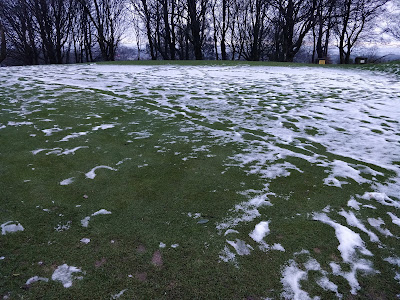Last week we took the opportunity to carry out essential maintenance on our greens and tees, work which we would normally do in a May window. Carrying it out in mid February hopefully means we can be less disruptive at the start of the playing season, keeping any maintenance to a minimum.
 |
| Just one week previous and the course was closed, covered in snow. Once the thaw began, we could plan our maintenance |
| Poster in locker room |
The purpose of hollow coring is mainly for soil exchange, pulling out poor quality soil and thatch which holds moisture at the surface level, as well as allowing air and water to penetrate into the rootzone. There is a poster in the locker rooms that further explains the process.
 |
| At the top, a core taken from a tee to help remove compaction. At the bottom, a core from a green showing the organic matter we wish to remove and replace |
The holes created are then filled with a much more free draining material, so that the greens in the long run are firmer and therefore smoother. We have used a topdressing sand which has been dried to remove any moisture, therefore it can fill the holes much more efficiently.
Although it is a disruptive and lengthy process, we actually are only targeting around 5-7% of the surface area each time we do it. Ideally in a year you would try and remove around 20% material to maintain good quality surfaces. That is why regular maintenance is necessary. A granular fertiliser is applied to aid recovery.
The process starts with the efficient Procore pulling out the cores in a square pattern. These are collected and discarded.
 |
| The Procore was used on the greens, here pictured without the collection box |
Then topdressing is applied with the truck mounted spin dresser. This is a very efficient way to distribute the dressing over a large area.
 |
| Topdressing applied |
 |
| Spin dresser applying the dressing |
After this we then pull the sweep and fill brush over the greens to fill up all the holes.
 |
| Sweep and Fill Brush |
The greens are then rolled with the turf iron to smooth them out. Obviously there are a lot of machines going over the greens and so in the short term the surfaces have a lot of wheel marks on them. The iron helps to remove them.
As well as hollow coring we also hired the used of the Sandcat machine from the contractor Greener Grounds. This tractor mounted machine decompacts the subsurface by shaking the ground underneath. It also creates slits in the ground down to around 6 inches. The sand hopper then releases the dried sand down into the slits, helping to firm the ground.
 |
| The Sandcat, slicing, decompacting and filling |
We used this machine on the 2nd, 15th and 17th greens, which had been cored earlier. They brought a drone to illustrate how the work looks from a different perspective.
 |
| Sand slits. Moisture in the ground meant excess sand was brushed after |
 |
| Hopper carrying around half a ton of dried sand |

